Accepted Scientific Name: Rebutia spegazziniana Backeb.
Kakteen-Freunde ii. No. 1, (1933); Backeb. Blatter Kakteenforsch. 1934, Pr. 2,[p. 8].
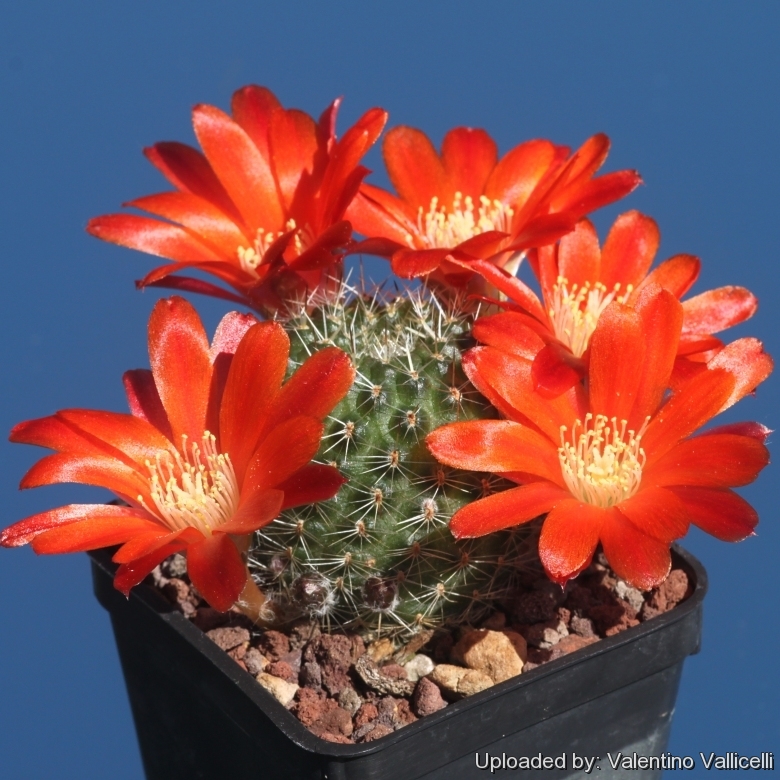
Rebutia patericalyx Photo by: Valentino Vallicelli
Origin and Habitat: Rebutia patericalyxSN|5044]]SN|5044]] has been reported from La Cueva, Chuquisaca, Bolivia.
Synonyms:
See all synonyms of Rebutia spegazziniana
back
Accepted name in llifle Database:Rebutia spegazziniana Backeb.Kakteen-Freunde ii. No. 1, (1933); Backeb. Blatter Kakteenforsch. 1934, Pr. 2,[p. 8].Synonymy: 35
back
Description: Rebutia patericalyxSN|4953]]SN|5044]] Ritter (1977) is one of the controversial forms of the widespread and variable Rebutia spegazzinianaSN|5044]]SN|5033]]. It is noted for the smallish solitary to sparingly clustering stems. The spines are 3 to 6mm long, pointing sideways, pale yellow to white and covered by minuscule hairs visible only under lens. The flowers are scarlet. However the distinguishing characteristics of Rebutia patericalyxSN|5033]]SN|5044]], appear to fall within the natural variation of Rebutia spegazzinianaSN|5044]]SN|5033]] and most authors synonymize it with the latter, but it still has a value for a collector because they identify plants with particular characters. Regrettably most plants in cultivation under this name seldom match up to the original description, being usually raised from commercial seed which has often been wrongly identified, and this is sadly often the case with Ritter plants.
Derivation of specific name: 'patericalyx', from Latin 'patera', bowl, and Latin 'calyx', calyx, cup, a bowl-shaped cup, and refers to the shape of the flower.
Stems: Single-stemmed to sparsely clustering, green, 1.3 to 3 cm wide.
Ribs: 13 to 16 ill-defined.
Areoles: 1-2 mm long, with white wool.
Spines: 12-15, pale yellow to white, pointing sideways, 3 to 6mm long, sometimes with one similar central spine. All with tiny pubescent hairs visible only with a magnifying glass,
Flowers: Scarlet , 3.5 cm or more cm long and wide. Pericarpel with white wool and bristles.
Note: Rod and Ken Preston-Mafham (1997) proposed a different classification and placed Rebutia patericalyxSN|5033]]SN|5044]] as a synonym of Rebutia deminutaSN|5044]]SN|4953]] (Web.) Br.& R.
Subspecies, varieties, forms and cultivars of plants belonging to the Rebutia spegazziniana group
- Rebutia froehlichiana Rausch
 Rebutia fusca F.Ritter: has tiny bristle spines and vibrant orange-red flower. Distribution: Oruro, Tarija, Bolivia.
Rebutia fusca F.Ritter: has tiny bristle spines and vibrant orange-red flower. Distribution: Oruro, Tarija, Bolivia.- Rebutia mamillosa Rausch: has dark greenish brown bodies becoming bronzed purple in full sun and forms small clumps of small heads around 20 mm across. Flowers dark red, ca. 2,5 cm in diameter with showy white stamens. Distribution: west of Camargo and adjacent areas, Chuquisaca, Bolivia.
 Rebutia mamillosa var. australis F.Ritter: has bodies 20-30 mm wide, 10-15 ribs, 12-20 radial spines, 3-6 mm long and 0-4 centrals equal in length. Flowers 26-46 mm long with white filaments. Distribution: Habitat, San Antonio, Prov. Mendez, Bolivia.
Rebutia mamillosa var. australis F.Ritter: has bodies 20-30 mm wide, 10-15 ribs, 12-20 radial spines, 3-6 mm long and 0-4 centrals equal in length. Flowers 26-46 mm long with white filaments. Distribution: Habitat, San Antonio, Prov. Mendez, Bolivia.- Rebutia mamillosa var. orientalis F.Ritter: has areoles abundantly filled with white wool, 0-4 radial spines, 5-7 mm long, darker at base. Distribution: Tarija towards the south, Bolivia.
 Rebutia patericalyx F.Ritter: has vibrant orange-red flower and tiny bristle spines covered by tiny hairs. Distribution: La Queva, Chuquisaca, Bolivia.
Rebutia patericalyx F.Ritter: has vibrant orange-red flower and tiny bristle spines covered by tiny hairs. Distribution: La Queva, Chuquisaca, Bolivia.- Rebutia rubiginosa F.Ritter
 Rebutia spegazziniana Backeb.: widespread and variable species that will clump with age and produces large and beautiful bright red flowers. Distribution: Bolivia and Argentina.
Rebutia spegazziniana Backeb.: widespread and variable species that will clump with age and produces large and beautiful bright red flowers. Distribution: Bolivia and Argentina. Rebutia spegazziniana var. atroviridis (Backeb.) Šída: has darker bluish grey-green skin and lighter, weaker spines. Blooms dark red. Distribution: Bolivia and Argentina.
Rebutia spegazziniana var. atroviridis (Backeb.) Šída: has darker bluish grey-green skin and lighter, weaker spines. Blooms dark red. Distribution: Bolivia and Argentina. Rebutia spegazziniana var. boliviensis n.n., Rausch
Rebutia spegazziniana var. boliviensis n.n., Rausch- Rebutia sumayana Rausch
- Rebutia tarijensis Rausch
 Rebutia tarvitaensis F.Ritter: has grey-green to olive-green epidermis with violet tints and orange-red blooms. Distribution: Tarvita, Chuquisaca, Bolivia.
Rebutia tarvitaensis F.Ritter: has grey-green to olive-green epidermis with violet tints and orange-red blooms. Distribution: Tarvita, Chuquisaca, Bolivia.- Rebutia tuberosa F.Ritter
 Rebutia vulpina F.Ritter: Flowers are bright red, the petals tipped scarlet, stigma and stamens white. Distribution: Bolivia, Tarija, Mendez, west of Tarija.
Rebutia vulpina F.Ritter: Flowers are bright red, the petals tipped scarlet, stigma and stamens white. Distribution: Bolivia, Tarija, Mendez, west of Tarija.- Rebutia zecheri Rausch
Bibliography: Major references and further lectures
1) John Pilbeam “Rebutia” Cirio Pub. Services, 01 May 1997
2) Rod and Ken Preston-Mafham “Cacti: The Illustrated Dictionary” 1997
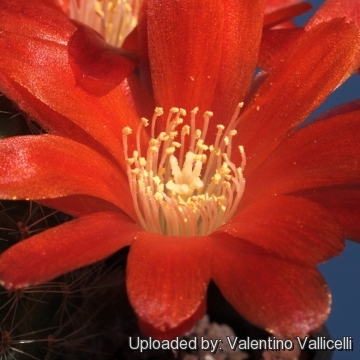 Rebutia patericalyx Photo by: Valentino Vallicelli
Rebutia patericalyx Photo by: Valentino Vallicelli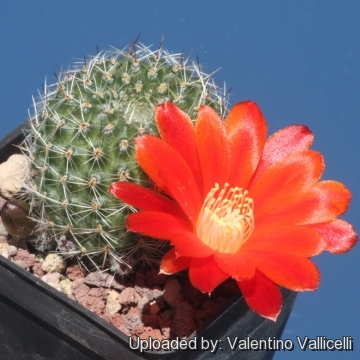 Rebutia patericalyx Photo by: Valentino Vallicelli
Rebutia patericalyx Photo by: Valentino Vallicelli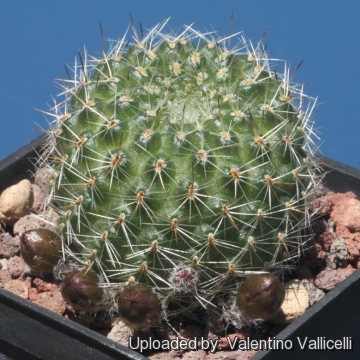 Rebutia patericalyx Photo by: Valentino Vallicelli
Rebutia patericalyx Photo by: Valentino Vallicelli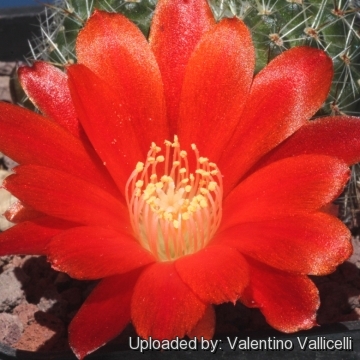 Rebutia patericalyx Photo by: Valentino Vallicelli
Rebutia patericalyx Photo by: Valentino VallicelliCultivation and Propagation: It is easy to grow and recommended for beginners. Prefer gritty, porous mix with a pH slightly on the acidic side. Full sun to light shade, Water regularly in summer but do not overwater (the root system is rot prone) and allow the pot to dry out between waterings. Keep dry in winter Hardy to -4°C it will take low temperatures when dry and do require a winter rest period. This species will occupy a small flower pot comfortably and remain a manageable sized house plant.
Pest and disease: This plants are subject to mealy-bug attack and to fungus and rot problems brought about by overwatering and high humidity.
Propagation: Seed or offsets.














